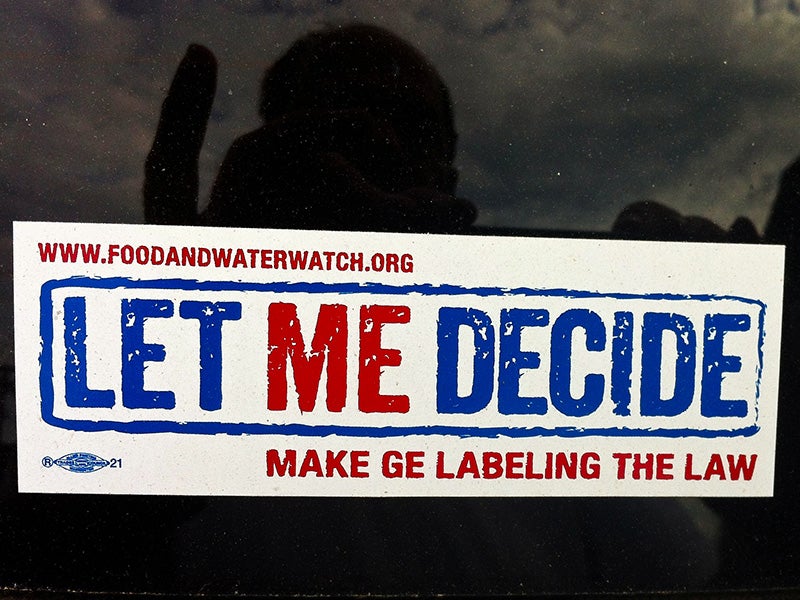Genetically Engineered Crops: Coming to a Store Near You?
Consumers fight for protections and labeling.

This page was published 11 years ago. Find the latest on Earthjustice’s work.
This month, Maine became the second state in the nation to require labels on food that contains genetically engineered (GE) ingredients. The state’s decision is part of a growing, nationwide effort to assert the right of consumers to know what they’re eating. Currently, more than 26 states are considering proposals to require labeling of altered foods, including Hawaiʻi, where Earthjustice is pushing for laws requiring labeling of GE products.
Despite support from 9 out of 10 Americans for labeling, the USDA recently made it even more likely that the next generation of GE corn and soy will soon be on the market—unlabeled and without any restriction or oversight whatsoever.
Are GE crops more nutritious or better tasting? Do they grow with less water or have higher yields? No on all accounts. Most GE crops to date have been created solely to resist herbicides. The most popular have been Monsanto’s “Roundup Ready” crops, which tolerate the Roundup herbicide with glyphosate, its active ingredient. These crops offer consumers no benefit, but they allow farmers to freely douse their fields with herbicides without killing the crop. This convenience resulted in half a billion additional pounds of toxic herbicide being sprayed on U.S. fields between 1996 and 2011.
Increased herbicide isn’t the only problem brought by these crops. When the same herbicide is sprayed on a field repeatedly, a few naturally resistant weeds survive, reproduce and eventually take over. Now, more than 60 million acres of U.S. cropland are infested with glyphosate-resistant weeds. Industry’s solution to this problem was just to genetically engineer crops to resist a different, more toxic herbicide: 2,4-D.
These new corn and soy varieties, known by the trade name “Enlist,” are engineered by Dow Agrosciences to resist the effects of the herbicide 2,4-D, and other herbicides. If 2,4-D sounds familiar, that’s because it’s infamous for being a major component of Agent Orange, the Vietnam War-era defoliant. The herbicide itself is toxic to the liver in small doses, is associated with higher risk of Lou Gehrig’s disease, malformed sperm, and possibly non-Hodgkin’s lymphoma. It’s currently not approved for use on lawns and gardens in Sweden, Denmark, Norway, Kuwait and the Canadian provinces of Québec and Ontario. Meanwhile, the USDA acknowledges that allowing these crops on the market will likely more than triple use of 2,4-D in the U.S.—an increase of tens of millions of pounds per year.
In addition to increased use of a toxic herbicide, these new crops carry all the same problems as the old ones. Just as Roundup-resistant crops produced millions of acres of glyphosate-resistant weeds, constant use of 2,4-D on fields of these crops will inevitably lead to 2,4-D-resistant weeds, further escalating the cycle of weed resistance and chemical use. Wildlife living in and around croplands will see 2,4-D drifting into their habitats, threatening their existence. Biodiversity will continue to drop as monocultures of corn and soy dominate the landscape. Neighboring organic and conventional farmers will risk damage from drifting herbicide, and will have to test their crops for transgenic contamination or risk losing their GE-sensitive markets. Contamination will continue regardless, since it can and does happen in so many ways, from cross-pollination to all kinds of human error. And with industry fiercely resisting the labeling of GE products, consumers will continue to be denied the right to know what they’re eating.
Yet the USDA, instead of being more alert to these issues and seeking to ameliorate them, tries harder and harder to avoid dealing with them. It refuses to look at impacts of transgenic contamination or higher 2,4-D use on people, plants, or wildlife. Worse, it takes the position that these are not its responsibility, although it’s USDA’s approval that’s causing these impacts. As for the herbicide’s effects, the USDA says that’s the EPA’s problem, but it remains to be seen whether the EPA will restrict this program in any way. And as far as the USDA is concerned, farmers and consumers are on their own if they want to avoid buying, selling, growing or eating GE products.
Left with little assistance from the federal government, states are taking it upon themselves to protect their communities from GE foods and their herbicides. Recently in Hawaiʻi, the Kauaʻi County Council passed an ordinance requiring disclosure of pesticide use, buffer zones around sensitive areas, and disclosure of GE crops being grown. The ordinance was passed following several incidents where students at a local school fell sick after pesticide spray drifted into the school yard. Upon the ordinance’s passage, three multinational agrichemical companies—Dow, DuPont, and Syngenta—sued the Council. Earthjustice testified in favor of the ordinance and now is preparing to go to court to intervene on behalf of community groups to defend the county law and Kaua’i’s residents.
If you’re concerned about the impacts of allowing a new generation of GE crops to grow freely, support our fight by submitting comments on the USDA’s Environmental Impact Statement at http://www.regulations.gov/#!submitComment;D=APHIS-2013-0042-0050.
Established in 1988, Earthjustice's Mid-Pacific Office, located in Honolulu, Hawaiʻi, works on a broad range of environmental and community health issues, including to ensure water is a public trust and to achieve a cleaner energy future.